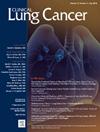Durvalumab巩固治疗LA-NSCLC患者进展后的治疗结果。
IF 3.3
3区 医学
Q2 ONCOLOGY
引用次数: 0
摘要
简介:太平洋建立了巩固durvalumab治疗LA-NSCLC,但只有大约一半的患者完成了一年的治疗。杜伐单抗治疗模式和结果的数据有限。方法:我们的分析包括来自美国全国数据库的LA-NSCLC患者,他们在2017年至2023年期间接受了巩固性杜伐单抗,随后接受了全身治疗,分为PD-L1单药治疗、PD-L1+化疗、单独化疗、PD-L1+CTLA4或靶向治疗(TT)。从杜伐单抗开始和结束到下一个治疗线开始分析下一次治疗的时间(TTNT)。使用Kaplan Meier方法分析从durvalumab治疗开始的总生存期(OS)。结果:我们的队列包括751例患者,中位年龄68岁(IQR, 61-74), 53%女性,80%白人,91% ECOG 0-1, 90%吸烟史,53%非鳞状组织。最常见的durvalumab后治疗是349例(46%)单独化疗,其次是PD-L1+化疗147例(20%),PD-L1单药治疗114例(15%),TT治疗104例(14%)。杜伐单抗治疗的中位持续时间为5.5个月(IQR 2.3-10.6);只有9%的患者接受了整年的durvalumab治疗,64%的患者在开始治疗的一年内开始了下一次治疗。接受含化疗方案治疗的患者从durvalumab开始/结束的TTNT更短,中位OS也更短[化疗组10.8(5.6-18.8)个月,化疗免疫组12.9(6.0-24.2)个月,而PD-L1单药治疗组23.8(8.7-34.5)个月,TT组30.1 (9.5-NR)个月(P < 0.001)]。结论:杜伐单抗联合治疗后接受全身治疗的患者,特别是需要以化疗为基础的患者,预后较差,需要改进治疗策略。本文章由计算机程序翻译,如有差异,请以英文原文为准。
Outcomes Following Treatment for Progression in Patients Treated With Durvalumab Consolidation in LA-NSCLC
Introduction
PACIFIC established consolidative durvalumab for LA-NSCLC, but only about half of patients completed a year of therapy. Data on treatment patterns and outcomes after durvalumab are limited.
Methods
Our analysis included patients from a US nationwide database with LA-NSCLC who received consolidative durvalumab between 2017 and 2023 and had subsequent systemic therapy, classified as PD-L1 monotherapy, PD-L1+chemotherapy, chemotherapy alone, PD-L1+CTLA4, or targeted therapy (TT). Time to next treatment (TTNT) was analyzed from durvalumab start and finish to next line of therapy initiation. Overall survival (OS) from start of postdurvalumab therapy was analyzed using Kaplan Meier methodology.
Results
Our cohort included 751 patients, median age 68 (IQR, 61-74), 53% female, 80% White, 91% ECOG 0-1, 90% smoking history, and 53% nonsquamous histology. The most common postdurvalumab treatment was chemotherapy alone in 349 (46%), followed by PD-L1+chemotherapy in 147 (20%), PD-L1 monotherapy in 114 (15%), and TT in 104 (14%).
Median duration of durvalumab treatment was 5.5 months (IQR 2.3-10.6); only 9% of patients received a full year of durvalumab, and 64% started next treatment within a year of initiation. Patients treated with chemotherapy-containing regimens had shorter TTNT from durvalumab start/end, as well as shorter median OS [10.8 (5.6-18.8) months for chemotherapy and 12.9 (6.0-24.2) months for chemoimmunotherapy, versus 23.8 (8.7-34.5) months for PD-L1 monotherapy and 30.1 (9.5-NR) months for TT (P < .001)].
Conclusion
Patients treated with systemic therapy after consolidative durvalumab, particularly those requiring chemotherapy-based treatment, have poor outcomes and are in need of improved treatment strategies.
求助全文
通过发布文献求助,成功后即可免费获取论文全文。
去求助
来源期刊

Clinical lung cancer
医学-肿瘤学
CiteScore
7.00
自引率
2.80%
发文量
159
审稿时长
24 days
期刊介绍:
Clinical Lung Cancer is a peer-reviewed bimonthly journal that publishes original articles describing various aspects of clinical and translational research of lung cancer. Clinical Lung Cancer is devoted to articles on detection, diagnosis, prevention, and treatment of lung cancer. The main emphasis is on recent scientific developments in all areas related to lung cancer. Specific areas of interest include clinical research and mechanistic approaches; drug sensitivity and resistance; gene and antisense therapy; pathology, markers, and prognostic indicators; chemoprevention strategies; multimodality therapy; and integration of various approaches.
 求助内容:
求助内容: 应助结果提醒方式:
应助结果提醒方式:


